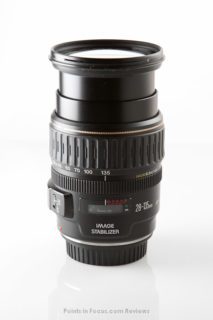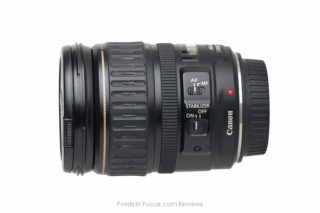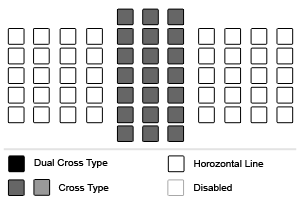Canon EF 28-135mm f/3.5-5.6 IS USM Lens Review
The EF 28-135mm f/3.5-5.6 IS USM is a mid-range general purpose zoom lens designed for Canon’s full frame cameras, but is equally at home on Canon’s crop bodies. The EF 28-135mm f/3.5-5.6 IS USM trades speed, some image quality, and a fixed aperture for a greater zoom range than it’s L or lower end kit counterparts, but compensates for that to some degree with an in lens image stabilization system.
Build and Construction
Fit and finish is quite good for a mid-tier lens. The EF 28-135mm f/3.5-5.6 IS USM lens is mostly plastic, but doesn’t feel cheap or plastic-y. In fact, the lens has quite a bit of heft, even with the plastic body, enough to warrant a metal lens mount. Unfortunately, that mount, like the rest of the lens, isn’t weather sealed.
The finish is a smooth un-textured matte black, not the “powered coated” textured finish found on many Canon lenses. That said, the finish doesn’t mar or scratch easily.
In fact, in my experience the EF 28-135mm f/3.5-5.6 IS USM is quite robust for its size and price. It’s most fragile component is the image stabilizer system, and even that can take quite a bit of punishment.
Like most low- and mid-range lenses, the zoom-ring is given “priority”; it’s wider and located at the front of the lens with the focus ring behind it. This is typically reversed on high-end lenses, where the zoom and focus rings are typically equal in size and focus ring tends to be the front most.

The zoom-ring on the EF 28-135mm f/3.5-5.6 IS USM is wide (the rubber grip is 7/8th inch, the whole part that turns is 1-3/8th inch) and textured rubber. The zoom-ring turns smoothly, though there is slightly more resistance starting from the shortest focal length. The complete zoom range is covered by turning the ring 90°. There is no zoom lock and the zoom can, and usually does, creep. Creep however, seems dependent on the specific lens; some lenses have a very pronounced creep others won’t creep at all.
Like most lenses in the wide to telephoto (walk around) range, the EF 28-135mm f/3.5-5.6 IS USM extends when zooming. Likewise, it follows the standard zoom design where the lens increases in length as the focal length increases and the hood is mounted on the end of the inner most lens barrel. As a result, the lens hood is most effective at the shortest focal length setting and increasingly less effective as the focal length is increased.
The extending lens barrel is composed of 2 parts. Because of this, there is a slight “wobble” or give in the front element that’s not there in single barrel lenses. However, the wobble seems to tighten up longer focal lengths. Moreover, I’ve never seen image quality issues due to this.
Autofocus on the EF 28-135mm f/3.5-5.6 IS USM is powered by a ring-USM motor. As a result, autofocus is fast and silent and full time manual focus is available. Additionally, the lens is of an internal focus design, so the front element doesn’t rotate or extend when focusing.
Manual focusing is done with a ½-inch wide hard plastic ring located near the middle of the lens. The complete focus range from close-focus to infinity is covered in 135°, which isn’t bad for an autofocus lens. While the ring is hard and plastic-y, it turns smoothly and feels good for a focus ring on a lens in this price range.

A distance scale is provided, though like most modern distance scales, its utility is limited. The internal focus design means that the infinity focus point can vary over a range with temperature and focal length. Because of that, it’s possible to focus past infinity. Finally, the distance scale lacks the hyperfocal/depth of field marks typically found on manual focus lenses. On the up side, the distance scale does have IR focus marks for all listed focal lengths.
The lens’s controls are rounded out with the autofocus/manual focus switch and image stabilizer switch. Both are located on the left side of the lens just behind the focus ring and use Canon’s older non-flat switch design.
The front of the lens features 72mm filter threads for protective and creative effect filters. 72mm has become something of a rarity in Canon’s line up these days, with the vast majority of lenses being either 77mm or 58mm.
Rounding out the features, the EF 28-135mm f/3.5-5.6 IS USM has a bayonet mount for a lens hood. Canon’s recommended lens hood is the EW-78BII, and this provider proper shading on a 5D, 1Ds or film EOS body. Unfortunately, the petals on the EW-78BII aren’t cut flat at the ends, so the lens won’t stand upright when set on the lens hood.
Performance
Optically the EF 28-135mm f/3.5-5.6 IS USM consists of 16 elements in 12 groups. It also has an aspheric element to help combat field curvature and spherical aberrations.
 Let’s be honest here, though, this isn’t an L lens and it doesn’t have L lens image quality. Quantitatively, objective tests show this lens has less resolution, more distortion, and higher CA than its L cousins do, though sometimes not by a whole lot. That said I’ve never had much of a complaint with this lens optically.
Let’s be honest here, though, this isn’t an L lens and it doesn’t have L lens image quality. Quantitatively, objective tests show this lens has less resolution, more distortion, and higher CA than its L cousins do, though sometimes not by a whole lot. That said I’ve never had much of a complaint with this lens optically.
Auto focus is quite and fast, thanks to the USM motor and internal focusing design. Focusing from infinity to a closer subject takes about 1s. Most focus moves, especially in good light, are considerably faster.
While the EF 28-135mm f/3.5-5.6 IS USM is not as fast as the 24-70 f/2.8L, the image stabilizer gives some breathing room as long as your subject isn’t moving. However, this lens uses one of Canon’s earliest image stabilizers so performance doesn’t stack up that well against lenses that are more modern. My testing and experience puts the IS system at about a stop and a half, give or take. On a full frame body that would mean handheld shutter speeds in the 1/15ths (w) to 1/80ths (t) range. On a crop body, speeds are about a stop faster 1/50ths (w) to 1/160ths (t).
The image stabilizer on the EF 28-135mm f/3.5-5.6 IS USM has a bit of an odd behavior. When shooting in portrait/vertical orientation, the stabilizer makes a noticeable diagonal shift when it engages or disengages. I’ve seen this on every copy of this lens I’ve handed, which leads me to believe this is normal behavior.
In the Box
Like all of Canon’s non-L lenses, the box contains very little beyond the lens. In the case of the EF 28-135mm f/3.5-5.6 IS USM the box contains the lens, as Lens Dust Cap E (rear cap), a 72mm snap on lens cap, instruction sheet, and warranty card. No hood ($30 extra) or pouch is included.
Alternatives
Canon produces 2 other full frame lenses in this range the EF 24-70mm f/2.8L USM and the EF 24-105mm f/4L IS USM, though either of these lenses cost about twice as much as the EF 28-135mm f/3.5-5.6 IS USM.
Compared to either of the L lenses, the 28-135 IS trades aperture, image quality, and wide angle for more reach. Whether that makes a difference is far more subjective. Compared to the EF 24-70 f/2.8L USM the 28-135 IS has almost twice as much reach. Though compared to the EF 24-105 f/4L IS USM, it’s not that much. Below is a comparison of 70mm, 105mm and 135mm with the same subject distance.
On a crop body, the EF 28-135mm f/3.5-5.6 IS USM has roughly the same field of view as a 50 to 200mm lens would have on a full frame camera. This put’s in a rather interesting, if a bit anachronistic, position. If you don’t shoot wide angle a lot, it’s a rather nice normal to telephoto zoom, with the widest setting being equal to the normal field of view produced by a 50mm lens on a film camera.
There’s not a lot of reason to go for the 28-135 IS USM on a crop body at this point. The EF-S 18-135mm f/3.5-5.6 IS covers the same range but goes wide enough to be a wide angle lens on a crop camera. It’s also lighter, though it doesn’t have the Ring-USM motor.
Verdict
Unfortunately the EF 28-135mm f/3.5-5.6 IS USM is a bit of an anachronism now. On a full frame, body the EF 24-105mm f/4L IS USM provides a constant aperture, better image quality, and weather sealing though at the cost of some of the telephoto reach and twice the cost.
On a crop body, the 28-135 is a normal to telephoto zoom, with an effective field of view equal to a 50-200mm lens. Here too the 28-135 has become an anachronism as well. The EF-S 55-250mm f/4-5.6 IS provides more reach and better pairing with the 18-55mm kit lens or EF-S 17-55mm f/2.8 IS USM. Alternatively, the EF-S 18-135mm f/3.5-5.6 USM covers all of the range of the 28-135 and adds wide-angle capabilities.
About the only setup that that makes sense is pairing the EF 28-135mm f/3.5-5.6 IS USM with the EF-S 10-22mm f/3.5-4.5 USM. This pairing provides the equivalent coverage from 16 to 200mm (in full frame terms) with a gap from 35 to 50mm in 2 lenses. Though neither is super-fast, they don’t take up a lot of bag space and provide a lot of flexibility.
One other thing that hurts the EF 28-135mm f/3.5-5.6 IS USM is that it’s a very popular starter/kit lens and that popularity coupled with its mid-tier build and optical quality, ultimately reduce the lens’s resale value. Used 28-135’s fetch maybe half of their new price.
One other thing to consider, if you’re using this lens on a crop body, the recommended hood doesn’t provide optimal shading (since it’s designed for a full frame sensor’s angle of view). Since the hood isn’t included by default, this means you can opt to buy an alternative if you wish. The alternative is the Canon EW-78C. This is the hood from the EF 35mm f/1.4L USM, and while it doesn’t provide ideal shading either, but it does provide better shading and is slightly better built as well.
In short: There are better choices out there now, but this is still a good lens if it fits your budget and needs.
Lens Data





Comments
There are no comments on this article yet. Why don't you start the discussion?